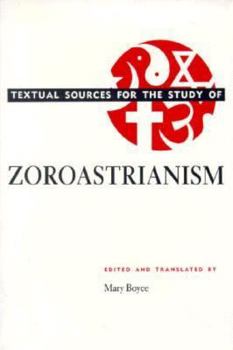Textual Sources for the Study of Zoroastrianism
Select Format
Select Condition 
Book Overview
"Boyce is a, perhaps the, world authority on Zoroastrianism. . . . Prefaced by a 27-page introduction, this anthology contains selections which offer a complete picture of Zoroastrian belief, worship and practice. There are historical texts from the sixth century B.C. onwards, and extracts from modern Zoroastrian writings representing traditionalism, occultism and reformist opinion. Anyone wishing to know more about this 'least well known of the world...
Format:Paperback
Language:English
ISBN:0226069303
ISBN13:9780226069302
Release Date:October 1990
Publisher:University of Chicago Press
Length:176 Pages
Weight:0.65 lbs.
Dimensions:0.6" x 6.1" x 9.1"
Customer Reviews
4 ratings
In the name of Iran
Published by Thriftbooks.com User , 17 years ago
This is a great book if you want to learn how certian concept of Zoroastrian faith emerged on Judism, Christianity and Islam; such as, after life, how Auhra Mazda judges people, and good people will be able to pass a bridge and wrong doers will fall off the bridge. There was one point that Zoroastrian did not share with other faith which was fasting. Last, fire means justice, and Zoroastrian people do not worship fire, as a matter of fact they worship just one God, and call their God Ahura Mazda which means the Wise Lord. The book briefly discussed how Zoroastrian faith shaped ancient political system in Iran. It is a nice book to read and have fun.
Finally some good primary sources
Published by Thriftbooks.com User , 21 years ago
This book is a real gem as is the whole series. Series editor John Hinnels, himself an expert on Zoroastrianism he wrote Zorastrians in Britain, has done a good job of getting many experts to put together the most important sources on the world religions. In this one Mary Boyce, the authority on Zoroastrianism and Professor emeritus at the University of London gives us some basic sources. Anyone studying Zoroastrianism knows that new editions of the primary sources dont come out very often. This book contains only selections of the Avesta, Vendidad and other works unfortunately. However, it does contain many other sources including works from Herodutos, Strabo and my personal favorite a newspaper report of the new Atash Bahram in Bombay dated 1897. This is essential for anyone with an interest in the subject.
Excellent Literary Excavation, Dubious Date
Published by Thriftbooks.com User , 22 years ago
If you're interested in Zoroaster and the religion that came to bear his name, this book is essential reading. In it, Mary Boyce extracts and organizes texts from the now-(I gather)-degenerate form the Avesta has taken in the centuries since the religion became marginalized by Muslim conquest, into a comprehensible, rational sequence covering the the entire history of the religion. The translations are clear. The only caveat I have is her justification of a late Bronze Age date for the time of Zoroaster's life. Other than the archaic language of the Gathas and the simplicity of the society presupposed in the text, she offers no evidence, archaeological or otherwise, for the preservation, transmission, and flowering, in the later Persian empire, of Zoroaster's singular viewpoint. She requires a huge leap of faith the reasonable reader shouldn't have to make. For this reason, William Malandra's "Introduction to Ancient Iranian Religion" is a valuable companion and counterpoint. When reading about archaic language and viewpoints, it's good to keep in mind our own experience with King James English and pastoral religious imagery, in a society where most people speak modern English and have no direct experience shepherds or sheep, except in movies and old-fashioned books!
Excellent Literary Excavation, Dubious Date
Published by Thriftbooks.com User , 22 years ago
If you're interested in Zoroaster and the religion that came to bear his name, this book is essential reading. In it, Mary Boyce extracts and organizes texts from the now-(I gather)-degenerate form the Avesta has taken in the centuries since the religion became marginalized by Muslim conquest, into a comprehensible, rational sequence covering the the entire history of the religion. The translations are clear. The only caveat I have is her justification of a late Bronze Age date for the time of Zoroaster's life. Other than the archaic language of the Gathas and the simplicity of the society presupposed in the text, she offers no evidence, archaeological or otherwise, for the preservation, transmission, and flowering, in the later Persian empire, of Zoroaster's singular viewpoint. She requires a huge leap of faith the reasonable reader shouldn't have to make. For this reason, William Malandra's "Introduction to Ancient Iranian Religion" is a valuable companion and counterpoint. When reading about archaic language and viewpoints, it's good to keep in mind our own experience with King James English and pastoral religious imagery, in a society where people speak modern English and have never seen shepherds or sheep!





